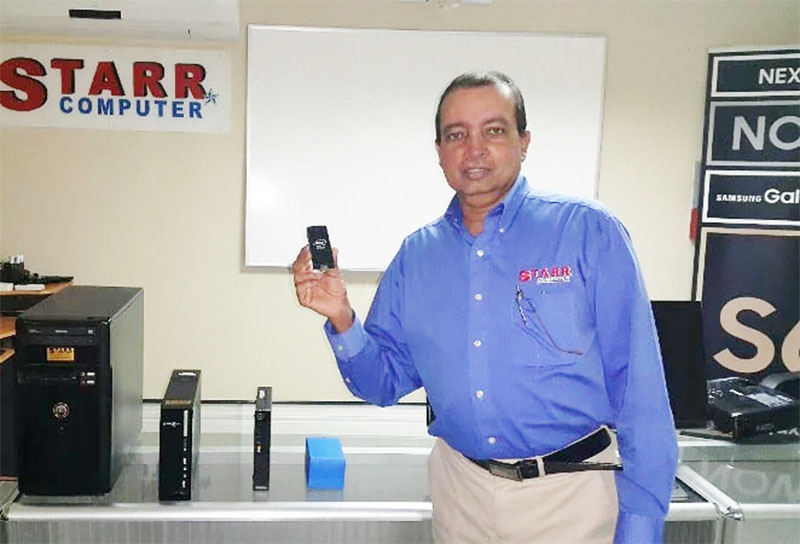With Starr Computers having done much to position itself at the head of the local information technology ‘pack’, the company’s Chief Executive Officer Mike Mohan never seems to tire in his efforts to ensure that the company continues to lead the way.
A week ago Mohan issued an invitation to media houses to visit what is currently the company’s expanding Brickdam complex to ‘experience’ what the invitation described as a ‘Smart Home, Smart School, Smart Business’ demonstration.
SMART, the acronym that stands for ‘self-monitoring, analysis and reporting technology’, describes technology that presses artificial intelligence into service “to provide cognitive awareness to objects’ which, hitherto, had been thought to be inanimate.
Last Friday, the company’s attractively laid out middle floor Technology Centre was the location of a low-key but informative product display and support ‘lecture’ by Mohan on the practical application of the SMART concept in the home, school, and business sectors.
In each of the three categories Mohan’s careful explanations on SMART technology and the ways in which it ‘upgrades’ the management of schools, homes, and businesses was attended by a bewildering array of gadgetry designed to enhance the efficiency of the three sectors.
What ought, perhaps, to have been a far better-attended media event was, for those who attended, an introduction to where information technology is taking us.
A ‘fully loaded’ Starr Computer ‘Smart Home’ offers a bewildering array of technology-driven gadgetry ranging from ‘smart’ security cameras to technology-controlled feeding stations for pets. Taken together, Starr’s SMART homes appear somewhat laden down with gadgetry though local technology ‘freaks’ may well relish the idea of simply ‘rocking back’ and getting through the day by simply putting the gadgetry through its paces. Both the Smart School and Smart Business sections of the display offered make-work-easy gadgetry some of which are already in place in some business. There is already a more than modest measure of evidence that some local business houses, determined to ‘raise their game’ to meet the demands of an oil-driven economy, are beginning to embrace SMART technology as an integral part of the framing of their respective business models.
If there is much to be said for the ‘Smart School’ (perhaps Smart Classroom is the more appropriate term here) it has to be said that what would appear to be the most market-ready section of the trilogy of technology demonstrations offered by Starr Computer’s recent technology display was missing the requisite market representatives from the education sectors. Various initiatives undertaken by the Ministry of Education, over time, reportedly to incrementally introduce the concept of the ‘smart classroom’ have fallen short of expectations on two counts. Education Ministry officials have expressed the view to this newspaper that the slow pace of the move towards Smart Classrooms is, in large measure “a matter of, first, affordability and secondly, a scarcity of teaching skills in the discipline.”
Seemingly suggesting that the time has come for the education system in Guyana to get with the programme as far as the enhanced integration of smart technology into the classroom is concerned, Starr Computer says in its related media release that “Smart School technology has now taken a life on its own. From the standard classroom environment of chalkboard and exercise books to a total digital platform Chalk Board,” which, the company says, “had morphed into touch screen board which quickly transitioned into Smart Interactive Projection.”
Mohan told Stabroek Business that Starr Computer is prepared to work towards a mutually agreeable arrangement that will enable more teachers and students to be exposed to the technology which the company is currently promoting.





